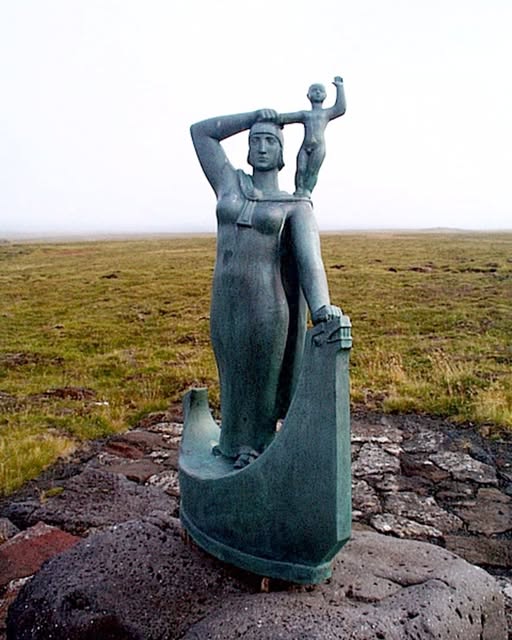Long before Columbus’s famed voyage, Gudrid Thorbjarnardottir, a remarkable Icelandic woman known as the “Far Traveler,” undertook a daring journey across the vast Atlantic. Her story, woven into the fabric of Viking sagas, is a testament to courage, resilience, and the pioneering spirit of early Norse explorers. Gudrid’s life, intricately linked to the Viking ventures into North America, offers a unique perspective on the role of women in these historic expeditions.
A Saga of Courage and Exploration
Gudrid’s life, documented in the sagas of the Greenlanders and Erik the Red, provides a compelling narrative of early Viking voyages to North America.
The Vinland Expedition and Early Settlement
Gudrid’s involvement in Thorfinn Karlsefni’s expedition to Vinland, believed to be modern-day Newfoundland, highlights her active participation in the establishment of Norse settlements in North America.

- Pioneering Journey:
- Gudrid’s journey to Vinland symbolizes the adventurous spirit of the Vikings and their determination to explore new territories.
- It highlighted pioneering journey.
- First European Birth:
- The birth of her son, Snorri, in Vinland marks a significant milestone, solidifying her place in history as the mother of the first European child born in North America.
- It showed first European birth.
- Saga Narratives:
- While the sagas contain fantastical elements, they also provide valuable historical context, offering insights into the challenges and triumphs of early Viking settlers.
- It highlighted saga narratives.
Women’s Role in Viking Society
Gudrid’s participation in these expeditions challenges traditional views of Viking society, showcasing the active role of women in exploration and colonization.
- Beyond Domestic Roles:
- Gudrid’s story demonstrates that Viking women were not confined to domestic roles but actively participated in long-distance voyages and settlement efforts.
- It showed beyond domestic roles.
- Key Figures in Colonization:
- Women like Gudrid played crucial roles in establishing and maintaining settlements, contributing to the survival and growth of Norse communities in new lands.
- It highlighted key figures in colonization.
- Challenging Stereotypes:
- Gudrid’s life challenges stereotypes about women’s roles in ancient societies, highlighting their resilience and adaptability in the face of adversity.
- It highlighted challenging stereotypes.
Archaeological Validation and Cultural Exchange
Archaeological discoveries have provided tangible evidence supporting the sagas and shedding light on the cultural exchange between Norse explorers and the indigenous populations of North America.
L’Anse aux Meadows and Spindle Whorl
The discovery of L’Anse aux Meadows and the spindle whorl artifact provides concrete evidence of Norse presence in Newfoundland around 1,000 A.D.
- Norse Settlement Confirmation:
- The L’Anse aux Meadows site confirms the historical accuracy of the sagas, demonstrating that the Vikings did indeed establish settlements in North America.
- It highlighted Norse settlement confirmation.
- Women’s Presence at the Site:
- The spindle whorl, a tool traditionally used by women for spinning wool, suggests that women were present at L’Anse aux Meadows, supporting Gudrid’s narrative.
- It showed women’s presence at the site.
- Timeline Alignment:
- The dating of the settlement to around 1,000 A.D. aligns with the timeline of Gudrid’s journey, further validating the sagas’ accounts.
- It highlighted timeline alignment.
Skagafjordur Longhouse and Cultural Transmission
The discovery of the longhouse in Skagafjordur valley highlights the cultural exchange between North America and Iceland, suggesting that Gudrid and her companions brought building techniques back to their homeland.
- Architectural Similarities:
- The striking resemblance between the longhouse in Skagafjordur and the turf houses at L’Anse aux Meadows suggests a direct connection between the two sites.
- It highlighted architectural similarities.
- Cultural Transmission:
- The architectural similarities indicate that Gudrid and her companions brought building techniques from North America to Iceland, demonstrating the cultural exchange that occurred during Viking exploration.
- It showed cultural transmission.
- Gudrid’s Final Home:
- The longhouse ties Gudrid’s story to a specific location in Iceland, providing further evidence of her life and travels.
- It highlighted Gudrid’s final home.
Conclusion:
Gudrid Thorbjarnardottir’s life story, validated by archaeological discoveries, stands as a testament to the pioneering spirit of Viking women and their crucial role in the exploration of North America. Her journey, chronicled in the sagas and supported by tangible evidence, highlights the courage and resilience of early Norse explorers and their enduring legacy.

CÁC TIN KHÁC
Mary Walton: The Forgotten Inventor Who Helped Clean Up America’s Cities
Tomb of Queen Nefertari in the Valley of the Queens, Egypt
Discover the Hypostyle Hall of the Temple of Hathor at Dendera
Venus de Losange: Unveiling the Mystery of a 20,000-Year-Old Paleolithic Icon